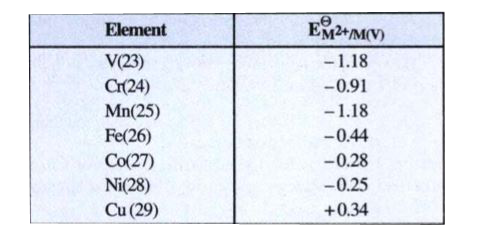The second and third row elements of transition maetals resemle each other much more than they resemble the first row because of
lanthanoid contraction which results in almost same radii of second and third row metals
diagonal relationship between second and third row elements
similar ionisation elethalphy of second and third row elements
similar oxidation states of second and third row metals.
The correct Answer is:A
To solve the question regarding why the second and third row elements of transition metals resemble each other more than they resemble the first row, we can follow these steps:
1. Understand the Transition Metals:
- Transition metals are found in the d-block of the periodic table. They are divided into three rows: the first row (3d), the second row (4d), and the third row (5d).
2. Identify the Key Concept:
- The key concept here is the lanthanide contraction. This refers to the phenomenon where the atomic and ionic sizes of the lanthanide series elements (elements 57 to 71) decrease as we move from lanthanum (La) to lutetium (Lu).
3. Explain Lanthanide Contraction:
- The lanthanide contraction occurs because the 4f electrons do not shield the nuclear charge effectively. As a result, the effective nuclear charge felt by the outer electrons increases, pulling them closer to the nucleus and resulting in smaller atomic radii.
4. Compare the Atomic Radii:
- Due to the lanthanide contraction, the atomic radii of the second row (4d transition metals) and third row (5d transition metals) transition metals become similar. This similarity in size leads to similar chemical and physical properties.
5. Conclusion:
- Therefore, the second and third row transition metals resemble each other much more than they resemble the first row because of the lanthanide contraction, which results in similar atomic radii.
Final Answer:
The second and third row elements of transition metals resemble each other much more than they resemble the first row because of the lanthanide contraction, which leads to similar atomic radii.
---
- Transition metals are found in the d-block of the periodic table. They are divided into three rows: the first row (3d), the second row (4d), and the third row (5d).
- The key concept here is the lanthanide contraction. This refers to the phenomenon where the atomic and ionic sizes of the lanthanide series elements (elements 57 to 71) decrease as we move from lanthanum (La) to lutetium (Lu).
- The lanthanide contraction occurs because the 4f electrons do not shield the nuclear charge effectively. As a result, the effective nuclear charge felt by the outer electrons increases, pulling them closer to the nucleus and resulting in smaller atomic radii.
- Due to the lanthanide contraction, the atomic radii of the second row (4d transition metals) and third row (5d transition metals) transition metals become similar. This similarity in size leads to similar chemical and physical properties.
- Therefore, the second and third row transition metals resemble each other much more than they resemble the first row because of the lanthanide contraction, which results in similar atomic radii.
The second and third row elements of transition metals resemble each other much more than they resemble the first row because of the lanthanide contraction, which leads to similar atomic radii.
Topper's Solved these Questions
- BOOK - NCERT FINGERTPS ENGLISHCHAPTER - THE D- AND F- BLOCK ELEMENTS EXERCISE - HOTS10videos
THE D- AND F- BLOCK ELEMENTS
- BOOK - NCERT FINGERTPS ENGLISHCHAPTER - THE D- AND F- BLOCK ELEMENTS EXERCISE - EXEMPLER PROBLEMS20videos
THE D- AND F- BLOCK ELEMENTS
- BOOK - NCERT FINGERTPS ENGLISHCHAPTER - SURFACE CHEMISTRYEXERCISE - Assertion And Reason15videos
SURFACE CHEMISTRY
- BOOK - NCERT FINGERTPS ENGLISHCHAPTER - THE P-BLOCK ELEMENTS EXERCISE - Assertion And Reason15videos
THE P-BLOCK ELEMENTS
Similar Questions
The second and third rows of transition elements resemble each other much more than they resemble the first row. Explain, why?
View Solution(a). Why do second and third rows of transition elements resemble each other more closely than the first row?
Give reasons:
(b). Most transition metals show paramagnetic behaviours.
(c). Transition metal and their many compounds are coloured.View SolutionSodium and potassium react with water much more vigorously than lithium because :
View SolutionAtomic radii of the transition elements are smaller than those of the s-block elements because:
View SolutionFlowering plants are more successful than other members of the plant world because
View SolutionFlowering plants are more successful than other members of the plant world because
View SolutionThe transition elements are more metallic then p - block elements because they have
View SolutionWhy are the second and third ionisation energies of group 13 elements much higher as compared to their first ionisation energies?
View SolutionGiven below are the electrode potential values, EΘ for some of the first row of transition elements :

Explain the irregularities in these values on the basis of electronic structure of atoms.View SolutionTransition elements are more electropositive–––––––––––––––––––––– than group 1 elements
View Solution

